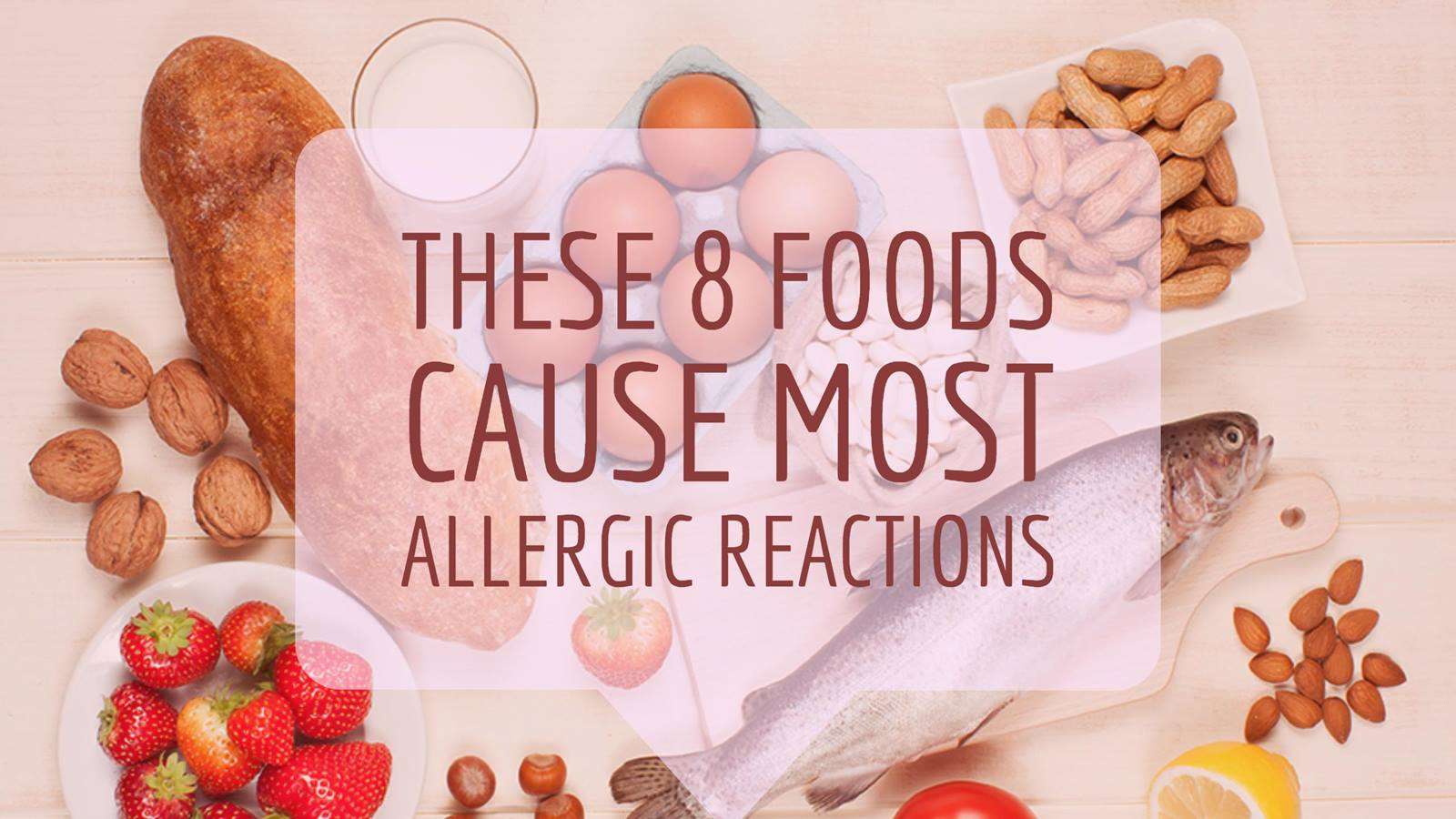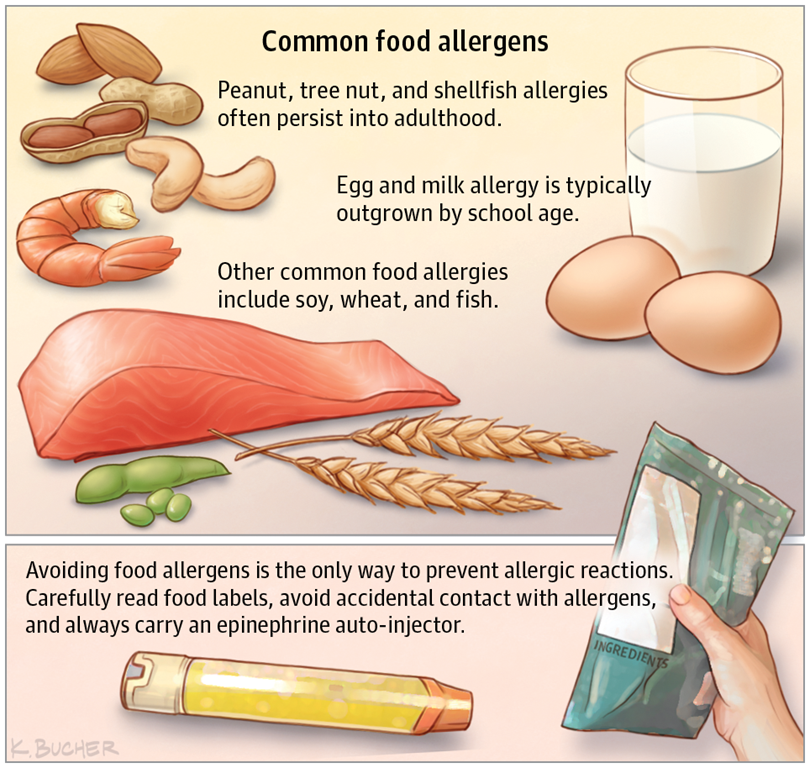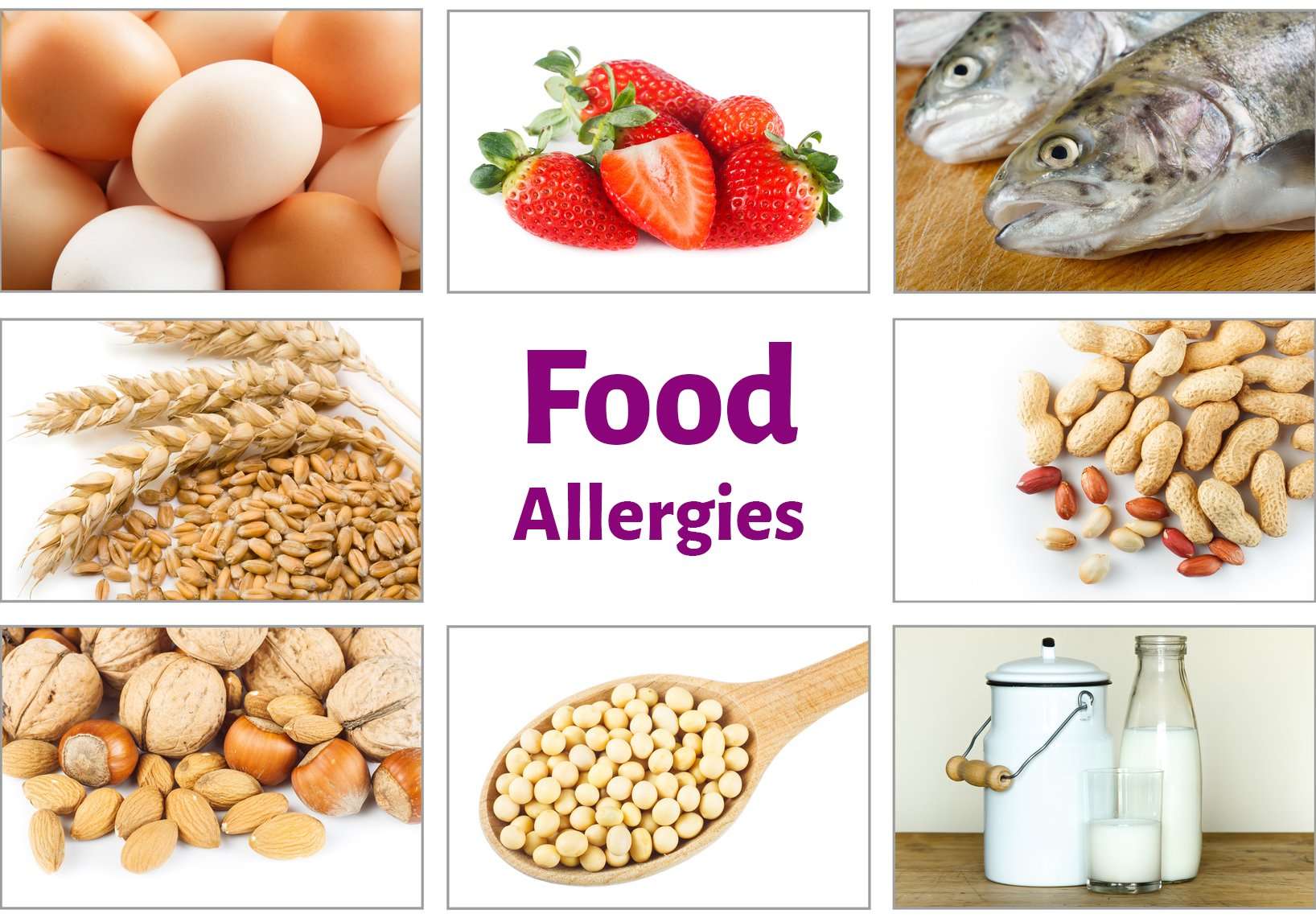Dining Out With Food Allergies
If your child has one or more food allergies, dining out can be achallenge. However, it is possible to have a healthy and satisfyingdining-out experience it just takes some preparation and persistence onyour part.
The American Dietetics Association offers these tips for dealing with foodallergies when your family is eating away from home:
-
Know what ingredients are in the foods at the restaurant where you plan to eat. When possible, obtain a menu from the restaurant ahead of time and review the menu items.
-
Let your server know from the beginning about your child’s food allergy. He or she should know how each dish is prepared and what ingredients are used. Ask about preparation and ingredients before you order. If your server does not know this information or seems unsure of it, ask to speak to the manager or the chef.
-
Avoid buffet-style or family-style service, as there may be cross-contamination of foods from using the same utensils for different dishes.
-
Avoid fried foods, as the same oil may be used to fry several different foods.
Alternately, there are several types of allergy cards available on theinternet that can be customized with your child’s personal information. Oneexample is the Food Allergy Buddy Dining Card, promoted by the NationalRestaurant Association.
Mild And Severe Symptoms
- Nose: itchy or runny nose, sneezing
- Mouth: itchy mouth
- Skin: a few hives, mild itch
- Gut: mild nausea or discomfort
Severe symptoms include:
- Lung: shortness of breath, wheezing, repetitive cough
- Heart: pale, blue, faint, weak pulse, dizzy
- Throat: tight, hoarse, trouble breathing/swallowing
- Mouth: significant swelling of the tongue or lips
- Skin: many hives over body, widespread redness
- Gut: repetitive vomiting or severe diarrhea
- Psychological: feeling something bad is about to happen, anxiety, confusion
What Skin And Blood Tests Diagnose The Causes Of Food Allergies
- Skin tests: In a percutaneous skin prick-puncture skin test, a dilute extract of the suspected food is placed on the skin of the forearm or back. This portion of the skin then is punctured or pricked with a needle and observed for swelling or redness, which would signify a local allergic reaction to the food. A positive prick-puncture test indicates that the patient has the IgE antibody that is specific for the food being tested on the skin’s mast cells. Skin tests are rapid, simple, and relatively safe.
- A person can have a positive skin test to a food allergen, however, without experiencing allergic reactions to that food. A doctor diagnoses a food allergy only when the patient has a positive skin test to a specific allergen and the history suggests an allergic reaction to the same food. In some highly allergic people, however, especially if they have had anaphylactic reactions, skin tests should not be done because they could provoke another dangerous reaction. Skin tests also cannot be done in patients with extensive eczema.
Recommended Reading: Generic Allergy Meds
Research For New Treatments
Food oral immunotherapy is being studied as a way to help treat food allergies. Under close supervision, a person takes in small daily doses of a food allergen by mouth or under the tongue. The goal is to try to make the immune system tolerate the allergen so that the body won’t react as badly to it. This is called desensitization. Talk to your doctor if you want to know more about for this and other new treatments being studied.
Groom Your Pet Regularly

Let`s face it, most dog owners do not bathe their dogs as required, usually due to a lack of time, or not enjoying the chore of grooming.
Either way failing to bathe your dog will contribute to the build-up of allergens in your dogs coat.
Regular brushing can also be great to loosen and remove dead skin cells, but if you already have allergy symptoms then breathing the loosened particles can give you a nasty reaction so wear a mask while you brush.
According to the Humane Society, bathing your dog at least once a week is sufficient to reduce the number of allergens in your dog by 84%.
Though a simple dip and scrubbing with plain water can do, it`s recommended that you bathe your dog using the a good dander shampoo.
Shampoo is not only essential for removing dander, but some have ingredients to improve your dogs skin, which in turn lowers the amount of dander produced.
Read our article about anti-itch shampoos for dogs to find out more.
You May Like: Can Allergy Medicine Raise Blood Pressure
What To Do If Your Child Has Allergy Symptoms
If your son or daughter has symptoms that may be allergy-related, finding their cause and a doctor to treat them can be a stressful experience for both you and your child. But the sooner you can identify the trigger for an allergy, the sooner you can help your child get back to just enjoying being a kid.
What Tests Are Used To Diagnose Food Allergies
If you suspect you have a food allergy, allergy/immunology providers can perform a skin test to confirm it. During a skin test, your healthcare provider:
Areas of your skin that become red and itchy indicate an allergy. Your healthcare provider uses this information to determine what youre allergic to.
Your healthcare provider may also use a radioallergosorbent blood test . A RAST checks the levels of allergic antibody to different allergens in your blood. Raised levels of specific antibodies can indicate an allergy.
You May Like: Mayo Clinic Allergies
Who Is At Risk
Anyone can experience a food allergy, but some risk factors make it more likely to develop:
- Family history: Food allergies can run in families. If close family members have asthma or any allergic diseases, including food allergies, eczema, and seasonal allergies, the person is more likely to develop food allergies.
- Other allergic conditions: A child with one allergic condition often develops others, too. These conditions include food allergies, asthma, and seasonal allergies.
- Early experiences:Research has shown that babies born by cesarean delivery may be more likely to develop food allergies. Introducing common allergens, such as peanuts, earlier in life can reduce the risk of food allergies developing.
- Gut bacteria:Some research shows that people with nut or seasonal allergies have altered gut bacteria. Specifically, they have higher levels of Bacteroidales and lower levels of Clostridiales strains. Scientists are trying to determine whether influencing gut bacteria could help treat or prevent allergies.
How To Prepare Your Younger Child For The Food Challenge
For younger children , you might find it helpful to do some role playing. For example, using words your child will understand, you can say: You and I are going to go to the allergists office. Youre going to get to eat a little bit of to see if your body is OK with it now. If everything is OK, youll then eat a little bit more and a little bit more. You can then play it out at home, pretending to do the test using a similar, allergen-free food.Answer any questions your child may have in clear, nonfrightening terms. Make sure your child understands youll be at the allergists office for a while, and let them feel like this will be a special time for the two of you to spend together. Some hospitals have child life specialists available to help with this process.
Also Check: How To Sleep Better With Allergies
How To Get Tested
A food allergy will usually cause some sort of reaction every time the trigger food is eaten. Symptoms can vary from person to person, and you may not always experience the same symptoms during every reaction. Allergic reactions to food can affect the skin, respiratory tract, gastrointestinal tract and cardiovascular system. It is impossible to predict how severe the next reaction might be, and all patients with food allergies should be carefully counseled about the risk of anaphylaxis, a potentially fatal reaction that is treated with epinephrine .
While food allergies may develop at any age, most appear in early childhood. If you suspect a food allergy, see an allergist, who will take your family and medical history, decide which tests to perform and use this information to determine if a food allergy exists.
To make a diagnosis, allergists ask detailed questions about your medical history and your symptoms. Be prepared to answer questions about:
- What and how much you ate
- How long it took for symptoms to develop
- What symptoms you experienced and how long they lasted.
After taking your history, your allergist may order skin tests and/or blood tests, which indicate whether food-specific immunoglobulin E antibodies are present in your body:
Your allergist will use the results of these tests in making a diagnosis. A positive result does not necessarily indicate that there is an allergy, though a negative result is useful in ruling one out.
Symptoms Of Food Allergies
- Hives all over and swelling of the face are the most common symptoms. Hives are raised pink bumps with pale centers . They look like bug bites.
- Mouth itching and swelling
- Runny nose and coughing
- Vomiting and diarrhea
- Life-threatening allergic reactions also must have trouble breathing and/or swallowing. The medical name for this is anaphylaxis. Most of these reactions have a sudden onset within 10 to 20 minutes. All occur within 2 hours of eating a certain food. People who have had this carry an emergency kit like an Epi-Pen.
Recommended Reading: What Allergy Medicine Is Stronger Than Zyrtec
What Foods Most Often Cause Food Allergy
Approximately 90 percent of all food allergies are caused by the followingeight foods:
-
Milk
-
Fish
-
Shellfish
Eggs, milk, and peanuts are the most common causes of food allergies inchildren, with wheat, soy, and tree nuts also included. Peanuts, tree nuts,fish, and shellfish commonly cause the most severe reactions. Nearly 5percent of children under the age of five years have food allergies. From1997 to 2007, the prevalence of reported food allergy increased 18 percentamong children under age 18 years. Although most children “outgrow” theirallergies, allergy to peanuts, tree nuts, fish, and shellfish may belifelong.
Natural Remedies For Seasonal Allergies

At this time of year, many people are suffering from seasonal allergies. The symptoms can include itching, sneezing, congestion and runny nose, headaches, red or watery eyes, and so on. They can vary from mild to severe, acute to chronic.
Seasonal allergies, sometimes referred to as hay fever, result from exposure to spores or pollen released into the atmosphere by fungi, grasses, trees, and other plants. That plant material is mistaken for an invasive protein by your bodys immune system, leading to the production of chemicals like histamine. Histamine attempts to attack or expel the invader, resulting in the bothersome symptoms described above. Those who experience seasonal allergies are also intolerant to certain foods which they cannot easily digest. The poorly digested food is often regurgitated back into the respiratory tract leading to many of the allergy symptoms noted above. The big food culprit is dairy products followed by eggs, poultry, red meat, bread/wheat, certain nuts, and alcohol. With the immune system becoming increasing compromised with continued consumption of the biggest food culprits, the person become more sensitized to other food triggers and environmental triggers.
1) Hydration through Water
When the respiratory and digestive systems are dehydrated, the immune system will cause a rebound effect leading to nasal congestion, runny nose, sneezing, and/or coughing. Do the following in order to optimize your hydration:
2) Saline nasal rinses
Recommended Reading: What Allergy Medicine Is Stronger Than Zyrtec
Regular Swimming Or Wet Itchy Ears
img source: medicalnewstoday.com
Regular swimmers tend to develop inner ear itching problem than those who do not swim regularly. This is due to too much moisture in ear, and possible exposure to the many germs in water bacteria and fungi. This case will be worse if your inner ear skin is broken.
Use a swim cap or ear plugs when you go swimming and use a cool blow dryer to remove any moisture from your inner ear after a shower or swimming. Ensure you do not get burnt.
Explaining Multiple Food Allergies
Some people have only heard of peanut and tree nut allergies, and may be unfamiliar with other food allergies. You will need to educate them about all of your allergens and the importance of taking all food allergies seriously.
Here are some tips:
- If you are a parent, explain calmly that your child carries an auto-injector and that each food allergy can trigger a reaction.
- For milk and wheat allergies, explain the difference between an allergy and an intolerance.
- Educational materials are very useful. You can print information about your allergens from our website and share them, or share the links.
- Invite friends and family to attend an awareness session, speaker or support group meeting with you.
- Have them take a free AllergyAware.ca course, and be sure to let them know that you appreciate their efforts.
- Not sure if an event will be allergy-friendly? Plan ahead. Bring your own food, volunteer to help at a party, or host extended-family holiday meals at your own home. Many people with multiple food allergies make a habit of carrying safe foods with them, just in case.
Don’t Miss: Can Allergies Make You Throw Up
Do Food Allergies Cause Skin Rashes
Food allergies typically cause symptoms such as shortness of breath, swollen lips, and an itchy skin rash known as hives. See a doctor who can help Find Allergists near you Hives tend to only appear after the allergen has been encountered, but usually are gone a short time later.
Living With Food Allergies
Living with food allergies can cause fear and anxiety when youre eating at a restaurant or someone elses home. You will always wonder if your problem food is combined with the rest of the meal. Also, if you have food allergies to most of the 8 common foods, you can feel frustrated by the restrictions in your life.
Don’t Miss: What Allergy Medicine Is Stronger Than Zyrtec
When To Call Your Healthcare Provider Right Away
- you experience swelling of the lips or tongue after eating
- you wheeze or have difficulty breathing after eating
- you have itchy hives over a large area of your body that appear soon after eating
- a baby is experiencing severe difficulty with feeding , or
- you have digestive symptoms after eating that are severe enough to cause symptoms of dehydration
These symptoms often indicate a food allergy that has the potential to develop into an anaphylactic allergy if your body encounters the offending food again. Your healthcare provider is likely to recommend further testing as soon as possible and may want to prescribe emergency medication in case of another, more severe reaction. Infant feeding difficulties need to be resolved quickly for the proper growth and comfort of the baby.
Severe digestive symptoms can indicate food allergies or several other acute conditions , but if these symptoms are severe enough to prevent you from replacing fluids, you may need treatment for dehydration in addition to an evaluation for food allergies or intolerances. Your healthcare provider may prescribe anti-vomiting or anti-diarrhea medication or may recommend you go to the hospital for rehydration treatments.
What Are The Most Common Food Allergens
A child could be allergic to any food, but these eight common allergens account for 90% of all reactions in kids:
In general, most kids with food allergies outgrow them. Of those who are allergic to milk, about 80% will eventually outgrow the allergy. About two-thirds with allergies to eggs and about 80% with a wheat or soy allergy will outgrow those by the time they’re 5 years old. Other food allergies may be harder to outgrow.
You May Like: Generic Zertec
What Causes Food Allergies
Food allergies happen when the immune system the body’s defence against infection mistakenly treats proteins found in food as a threat.
As a result, a number of chemicals are released. It’s these chemicals that cause the symptoms of an allergic reaction.
Almost any food can cause an allergic reaction, but there are certain foods that are responsible for most food allergies.
Foods that most commonly cause an allergic reaction are:
- milk
- shellfish
- some fruit and vegetables
Most children that have a food allergy will have experienced eczema during infancy. The worse the child’s eczema and the earlier it started, the more likely they are to have a food allergy.
It’s still unknown why people develop allergies to food, although they often have other allergic conditions, such as asthma, hay fever and eczema.
Tips To Avoid Foods That May Cause Allergies

To avoid foods to which you have an allergy, learn the terms used to describe these foods on food labels, for example:
- milk protein milk, non-fat milk solids, cheese, yoghurt, caseinates, whey, lactose
- lactose milk, lactose
- Nutrition Australia. Tel. 9650 5165
- ASCIA Guidelines for prevention of food anaphylactic reactions in schools, preschools and childcare centres, 2015 update, Australasian Society of Clinical Immunology and Allergy. More information here.
- Osborne NJ, Koplin JJ, Martin PE, et al 2011, Prevalence of challenge-proven IgE-mediated food allergy using population-based sampling and predetermined challenge criteria in infants, J Allergy Clin Immunol, vol. 127, no. 3, pp. 668-676. More information here.
- About food allergies, The Food Allergy and Anaphylaxis Network. More information here.
- Anaphylaxis, Department of Education and Early Childhood Development, Victorian Government. More information here.
- ASCIA Guidelines infant feeding and allergy prevention, 2016, Australasian Society of Clinical Immunology and Allergy. More information here.
- Allergens, Food Allergy Research and Education. More information here.
Read Also: Robitussin Allergy Cough Syrup

